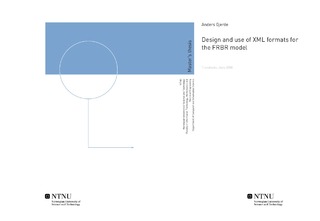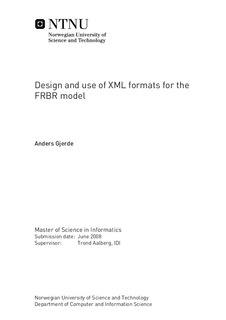| dc.description.abstract | This thesis aims to investigate how XML can be used to design a bibliographical format for storage of records better in terms of hierarchical structure and readability. It first presents introductory theory regarding the techniques which make the fundament of bibliographical formats and what has previously been in use. It also accounts for the FRBR model which is the conceptual framework of the format presented here. Throughout the thesis, several important XML design criteria will be presented and examples as to why these are important to consider when constructing a bibliographical format with the use of XML. Different implementation alternatives will be presented, with their advantages and disadvantages thoroughly discussed in order to establish a solid foundation for the choices that have been made. After having done this study, an XSD (XML Schema Definition) has been made according to the best practices that have been uncovered. The XSD is based on the FRBR Model, although it is slightly changed to accommodate the wishes and interests of librarians. Most noteworthy of these changes is that the Manifestation element has been made the top element with the Expression and Work elements hierarchically placed beneath Manifestation in that order. It maintains a MARC-based datatag structure, so that librarians who are already used to it will not have to readjust to another way of structuring the most common datafields. Relationships and other attributes however, are efficiently handled in language-based elements and the XSD accommodates new relationship types with a generic relation element. XSLT has been used to transform an existing XML database to conform to the XSD for testing purposes. Statistics have been collected from the database to support design choices. Depending on what the users' needs are, there are many different design choices. XML leads to more readable records but also takes up much space. When using XML to describe relational metadata, relationships can be expressed using hierarchical storing to a certain degree, but ID/IDREF will have to be used at some point to avoid infinite inclusion of new records. ID/IDREF may also be used to improve readability or save storage space. Hierarchical storing leads to many duplicated records, especially concerning Actors and Concepts. When using XML, one must choose the root element of the record structure according to which entity is the point of interest. In FRBR, there are several reasons to choose Manifestation as the root element as it is the focal point of a library record. | nb_NO |

